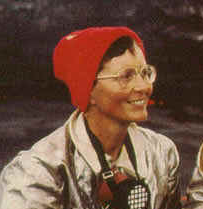Katia and Maurice Krafft are famous geologists and volcanologists who are known for their many feats. Even if you have never heard of their research, you have probably already heard of this couple braving the lavas and eruptions. They have gone into erupting volcanoes for students and take pictures and videos.
Biography
Katia Krafft
Katia Krafft was born on 17 April 1942 in Soultz-Haut-Rhin (Haut-Rhin, Alsace). Following the competition of the Ecole Normale in 1957, she studied physics and geochemistry at the University of Strasbourg. She obtained the prize of the Vocation Foundation in 1969, for her first work of volcanology on active sites
Maurice Krafft
![]()
Maurice Krafft was born on March 25, 1946 in Mulhouse. In 1951, Maurice Krafft witnessed an eruption at the Stromboli during a family trip. It is this eruption that will be at the origin of his vocation. At 14 years old, he became a member of the Société Géologique de France. After studying in Besançon and at the University of Strasbourg, he obtained a master’s degree in geology. He met on a study trip on Mount Etna in 1966 Haroun Tazieff, who integrated him in his team but the two men with strong characters separated thereafter. In 1968, with Roland Haas, he created Team Vulcain, then the Center de volcanology de Cernay.
Maurice and Katia Conrad meet at the faculty of Besançon. They marry and become companions of travel and geological studies.
The Volcano Devils
For 25 years, they travel the world together, privileging the camera and the camera. They are nicknamed the volcano devils (devils of the volcanoes) by their fellow volcanologists. They were attracted by volcanoes « like butterflies by light ». That’s how they came closer and closer to fuel their « bulimia of eruptions ». All this enriches an extraordinary iconographic fund, to this day still unrivaled.
They founded the Vulcain Volcanology Center in Cernay (Alsace) in 1968, and published their first book in 1971. From then on, they will together cover more than one hundred and fifty eruptions on all continents. They will publish about twenty books, make six feature films and participate in a number of television programs. Not to mention their competence as distinguished speakers and indefatigable, which nearly four million spectators were able to appreciate.
[kad_youtube url= »https://www.youtube.com/watch?v=-YKm37iGYcg » ]
Their Death
Maurice and Katia Krafft died on 3 June 1991, carried away by a pyroclastic flow on the flanks of Mount Unzen in Japan. The cloud also kills Harry Glicken, an American specialist in fiery clouds, as well as 41 others. Their bodies are found 2 days later. A stele is visible at the foot of Mount Unzen, where the names of the other victims are also inscribed in Japanese and Latin characters.
![]()
After their disappearance, the Krafft collection, unique in the world, was divided between the Museum of Natural History in Paris and the association « Images et Volcans« , created to manage an impressive collection of images: about two hundred thousand pictures and several hundred Hours of films.
Pyroclastic flow
A pyroclastic flow is a storm of hot gases at very high pressure carrying large amounts of lava debris (ashes and rocks). It covers hundreds of square kilometers of land in just a few hours. It can form during violent volcanic eruptions and travel at speeds over 100 km / h.
Here is a video showing the activity of a volcano producing a fiery cloud.
[kad_youtube url= »https://www.youtube.com/watch?v=rRKy3cehmnk » ]
Their works
Maurice Krafft directed many films, including « Vivre Sous la Menace des Volcans ». It was disseminated with the help of UNESCO in seven languages following the eruption of Nevado del Ruiz in 1985. This video has sensitized governments on the seven major volcanic hazards and the evacuation measures to be undertaken in Alert cases.
The Guide to European Volcanoes has also greatly encouraged the revival of geological studies and popularized the theory of plate tectonics. In this book, illustrated by his wife, Maurice Krafft presents petrography, the study of magma and a classification of eruptive mechanisms.
The couple initiated and participated in the House of the Volcano on the island of Réunion opened in 1992.
They also invested in Auvergne with an initial project, Volcania, which will form the premises of the European Park Vulcania. A part of the very beautiful collection of samples is presented in the permanent exhibition, in a space dedicated to them.
Many clichés they have realized during their career are on the site: science.vulcania.com
Their often rewarded career was honored by the Liotard Prize for Exploration. It was given to them on 25 February 1975 at the Elysée by the President of the Republic Valéry Giscard d’Estaing.
This encouraged many other adventures on the flanks of volcanoes to the sons of the years such as this video.
[Kad_youtube url = « https://www.youtube.com/watch?v=toxDDERtvOY »]



